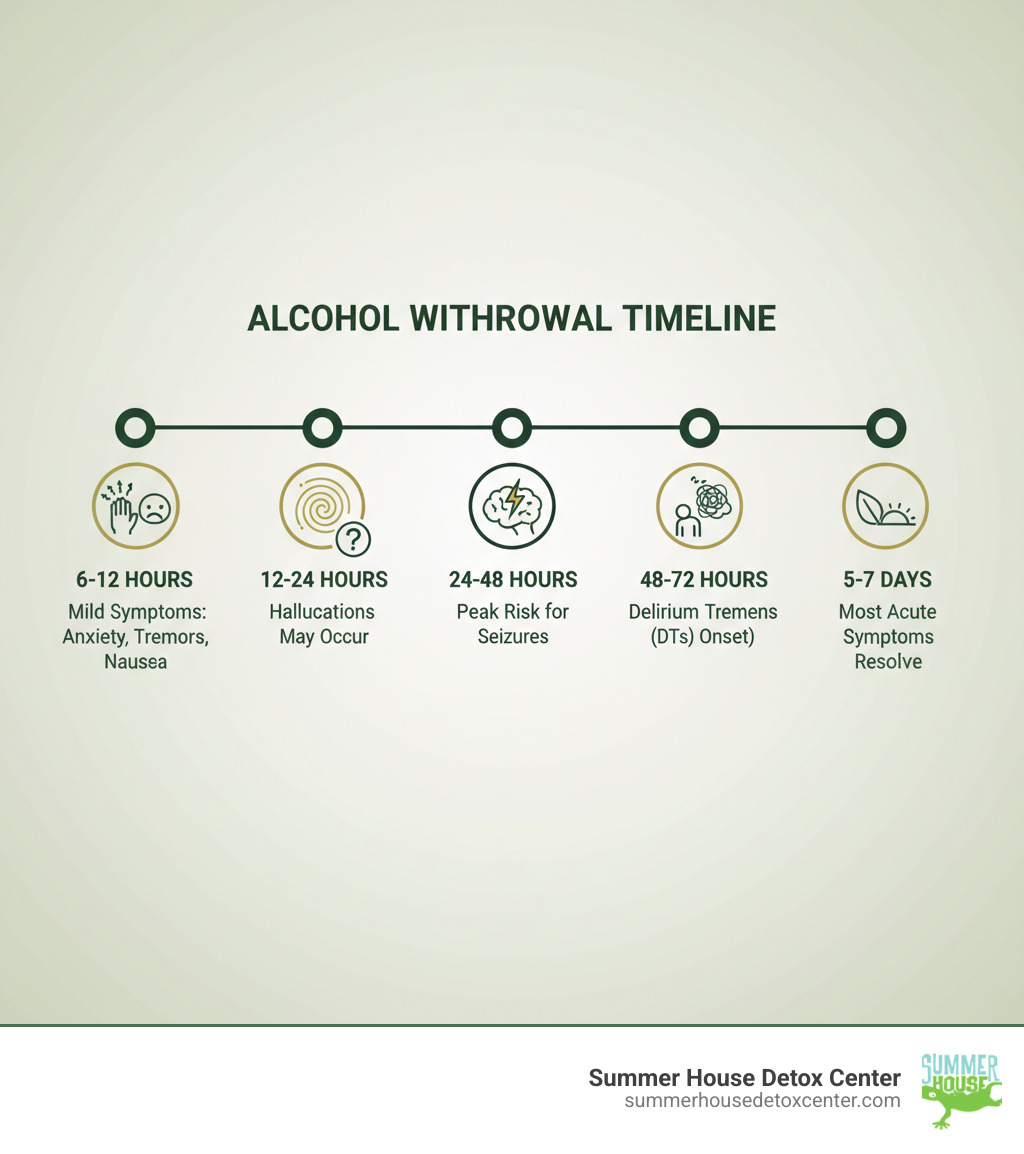Understanding Alcohol Withdrawal Syndrome and Why Medical Management Is Essential
How to manage alcohol withdrawal syndrome requires a structured, medically supervised approach that prioritizes patient safety, symptom relief, and long-term recovery. Effective management involves:
- Assessment – Using validated tools like the CIWA-Ar scale to determine withdrawal severity
- Medical Supervision – Providing 24/7 monitoring for moderate to severe cases
- Medication – Administering benzodiazepines as first-line treatment
- Supportive Care – Ensuring hydration, nutritional support, and thiamine supplementation
- Safe Environment – Creating a calm, quiet setting that reduces stimulation
- Transition Planning – Preparing for ongoing addiction treatment after detox
Alcohol withdrawal syndrome (AWS) affects about 50% of people with alcohol use disorder who suddenly stop or reduce their drinking. This is a potentially life-threatening medical condition. Chronic alcohol use suppresses the central nervous system; when alcohol is removed, the brain goes into overdrive, causing symptoms ranging from anxiety and tremors to seizures and delirium tremens (DTs).
The stakes are serious. While modern medical care has reduced mortality rates for severe withdrawal from a historical 15-20% to 1-5%, the risk remains. Attempting to detox alone is dangerous. For those in Miami and throughout Florida, understanding AWS management means knowing that safe, dignified care is available. Medical supervision transforms a frightening, potentially deadly experience into a managed process where your comfort and safety come first.
The Importance of Medically Supervised Detox: Why DIY Detox Can Be Dangerous explains why professional care makes all the difference.

Recognizing AWS: Symptoms, Timeline, and Complications
Your body reacts loudly when you stop drinking after long-term use. Recognizing these signs is the first step in knowing how to manage alcohol withdrawal syndrome safely.
The Progression of Withdrawal Symptoms
Withdrawal can start within six hours of your last drink as your nervous system goes into overdrive. The progression often follows a general timeline:
- 6 to 12 hours: Early symptoms appear. You may feel anxious and restless, with a racing heart, rising blood pressure, and uncontrollable hand tremors. Nausea, vomiting, and headaches are also common.
- 12 to 24 hours: Some people experience alcoholic hallucinosis—seeing or hearing things that aren’t there, though they are usually aware these hallucinations aren’t real.
- 24 to 48 hours: This window carries the highest risk for withdrawal seizures. These are typically severe, generalized tonic-clonic seizures that involve loss of consciousness. The risk is higher if you’ve gone through withdrawal before, an effect known as “kindling.”
- 48 to 72 hours: The potential for Delirium Tremens (DTs), the most dangerous stage, begins.
Even “mild” withdrawal deserves professional attention, as symptoms can escalate quickly. If you’re experiencing these signs, it’s time to seek help. Alcohol Withdrawal Signs: How to Know You Need Professional Alcohol Detox Treatment can help you understand what’s happening.

Severe Complications: Seizures and Delirium Tremens (DTs)
Withdrawal seizures and Delirium Tremens (DTs) are life-threatening complications that require immediate medical intervention.
Withdrawal seizures are full-blown, generalized tonic-clonic seizures that can be fatal without medical care, especially if they occur multiple times.
Delirium Tremens (DTs) affects about 3-5% of people in withdrawal, usually appearing 48 to 72 hours after the last drink. Symptoms include:
- Severe disorientation and confusion
- Profound agitation and restlessness
- Vivid, terrifying hallucinations
- Autonomic chaos: high fever, drenching sweats, and dangerously high heart rate and blood pressure.
With modern medical care, the mortality rate for DTs is 1-5%, but the risk of death is still very real. If you or someone you know shows signs of DTs or has a seizure during withdrawal in Miami or anywhere in Florida, call 911 immediately. This is why professional medical management is not optional—it’s a literal lifesaver. What to Expect During Alcohol Detox: A Step-by-Step Guide to the Process explains how medical supervision protects you.
How to Manage Alcohol Withdrawal Syndrome: Assessment and Treatment Protocols
How to manage alcohol withdrawal syndrome is guided by three goals: ensuring your safety, providing humane and comfortable care, and setting you up for long-term recovery. A critical first step is a differential diagnosis, as AWS symptoms can mimic other emergencies like sepsis. Our experienced Miami team evaluates each patient to ensure we’re treating the right condition. The Key to Experiencing a Safe Alcohol Detox explores these principles.

Assessing and Treating AWS Based on Severity
Effective management starts with understanding the severity of your symptoms.
Assessment with the CIWA-Ar Scale: We use the Clinical Institute Withdrawal Assessment for Alcohol, Revised (CIWA-Ar) scale to objectively measure withdrawal. This 10-item tool scores symptoms like tremor, sweating, and anxiety. The total score guides our treatment:
- Mild (score <8): Discomfort is present but manageable with close monitoring.
- Moderate (score 8-15): Medication is typically required for safety and comfort.
- Severe (score >15): Intensive medical intervention is necessary to prevent complications.
This scale allows for symptom-triggered therapy, where medication is given precisely when needed, leading to a shorter and more comfortable detox.
Treatment Protocols:
- Mild to Moderate Withdrawal: For mild cases (CIWA-Ar <8) with a strong support system and no history of severe withdrawal, outpatient management may be an option. However, inpatient management is the safer choice for moderate symptoms (CIWA-Ar >8), co-occurring conditions, or lack of home support. At our Miami facility, we provide 24/7 supervision and oral benzodiazepines like Diazepam or Lorazepam to calm the nervous system. Inpatient vs Outpatient Programs at Miami Alcohol Treatment Centers can help you choose.
- Severe Withdrawal: A CIWA-Ar score of 15 or higher, or any history of seizures or DTs, makes inpatient admission at a specialized Florida detox center absolutely critical. Severe withdrawal is a medical emergency requiring continuous monitoring. Treatment involves intravenous (IV) benzodiazepines to quickly control symptoms and prevent life-threatening complications. Dosages are carefully adjusted based on your response. This intensive, physician-led care cannot be replicated at home and is a vital first step toward recovery. Why Medical Detox Is a Vital First Step in Recovery explains this further.
Essential Supportive Care During Detoxification
Medication is vital, but how to manage alcohol withdrawal syndrome effectively also requires comprehensive supportive care. At Summer House Detox Center in Miami, we treat the whole person, addressing the physical and emotional toll of chronic alcohol use.
-
Hydration and Electrolytes: Dehydration is common. We use oral and, when needed, intravenous (IV) fluids to restore balance. We also replenish depleted electrolytes like magnesium and phosphorus, which can reduce seizure risk and improve heart function.
-
Nutritional Support: Malnutrition is a frequent consequence of alcohol use disorder. We provide balanced, nutritious meals and supplements to give your body the vitamins and minerals it needs to heal.
-
Thiamine (Vitamin B1) Supplementation: This is non-negotiable. Chronic alcohol use depletes thiamine, risking a serious neurological condition called Wernicke’s encephalopathy, which can lead to permanent memory damage (Korsakoff syndrome). We administer thiamine immediately upon admission, always before any glucose, to protect your brain.
-
A Calm, Safe Environment: Withdrawal makes you highly sensitive to your surroundings. Our Miami facility offers quiet, private rooms with minimal stimulation. This therapeutic setting helps calm your nervous system and reduces anxiety and agitation. Managing Withdrawal Symptoms: How Summer House Detox Center Helps You Through the Hardest Days details our approach.
-
Emotional Support and Reassurance: Withdrawal is frightening. Our compassionate staff, many in recovery themselves, provide constant reassurance. Explaining the process and reminding you that you are safe and cared for reduces fear and makes the experience more manageable. You are treated with dignity and empathy.

Long-Term Management and Recovery in Florida
Successfully detoxing is a huge first step, but it’s not the last. How to manage alcohol withdrawal syndrome effectively includes a plan for long-term recovery from Alcohol Use Disorder (AUD). Detox addresses the physical dependence; ongoing treatment is needed for the psychological aspects of addiction. At Summer House Detox Center in Miami, we ensure a seamless transition to comprehensive rehab programs.
-
Medication-Assisted Treatment (MAT): FDA-approved medications can reduce cravings and support abstinence. Naltrexone reduces the rewarding effects of alcohol, Acamprosate eases post-acute withdrawal symptoms, and Disulfiram creates an unpleasant reaction to alcohol, acting as a deterrent.
-
Behavioral Therapies: These are the core of long-term recovery. Cognitive Behavioral Therapy (CBT) helps you change negative thought patterns related to drinking, while Motivational Interviewing (MI) helps resolve ambivalence about change. Group and individual counseling provide a safe space to learn coping skills.
-
Peer Support: Mutual-help groups like Alcoholics Anonymous (AA) and Narcotics Anonymous (NA) are widely available in Florida and offer invaluable community and fellowship. Connecting with others who understand your journey is a powerful tool for maintaining sobriety.
-
Relapse Prevention: Long-term care focuses on building a sober life. This involves identifying triggers, developing stress management techniques, and creating a strong support network.
For those seeking support in Florida, Alcohol Detox and Recovery and Choosing the Best Miami Alcohol Rehab Center for Your Needs offer more insights into building a life in recovery.
Frequently Asked Questions about AWS Management
How long does alcohol withdrawal last?
The timeline varies, but acute symptoms typically begin within 6-12 hours, peak at 24-72 hours, and then gradually subside over 5-7 days. Some people experience Post-Acute Withdrawal Syndrome (PAWS), with milder symptoms like anxiety or insomnia lasting for weeks or months as the brain continues to heal. With medical support at our Florida facility, the entire process is managed for your comfort. For a detailed timeline, see our page on Alcohol Detox: How Long Does It Take?.
Can you manage alcohol withdrawal at home?
Attempting to manage moderate to severe alcohol withdrawal at home is extremely dangerous. The risk of sudden seizures or delirium tremens is unpredictable and can be fatal. Outpatient detox is only considered for the mildest cases under strict medical supervision with 24/7 support at home. Given the risks, medically supervised detox is always the safest choice. If you are at home and experience seizures, confusion, hallucinations, or chest pain, call 911 immediately.
What is the first-line medication for alcohol withdrawal?
Benzodiazepines are the gold-standard, first-line medication for managing AWS. They work by calming the overactive central nervous system, effectively preventing seizures, reducing anxiety, and lowering the risk of delirium tremens. Common examples used in our Miami facility include Diazepam (Valium), Lorazepam (Ativan), and Chlordiazepoxide (Librium). The specific medication and dosage are custom to your individual needs based on continuous assessment, ensuring a safe and comfortable detox. Learn more about What Type of Medications Are Used in Alcohol Treatment?.
Conclusion: Your Path to Safe Recovery in Miami
If you’ve made it this far, you now understand that how to manage alcohol withdrawal syndrome is a serious matter that requires professional care. AWS is a medical condition with life-threatening risks, from seizures to delirium tremens. Trying to tough it out alone isn’t worth the danger.
The gold standard for safety and comfort is medically supervised detox. This ensures you receive careful assessment, appropriate medication like benzodiazepines, and vital supportive care—including hydration, nutrition, and thiamine to protect your brain. Most importantly, it provides a safe, calm environment where you are treated with dignity by professionals who understand.
For those in Florida, this level of care is close to home. Summer House Detox Center in Miami provides personalized, physician-led treatment to guide you through withdrawal safely. Our compassionate team, many with their own recovery experience, is committed to your well-being.
This is your chance to break free. It starts with a safe detox, and you don’t have to do it alone.
